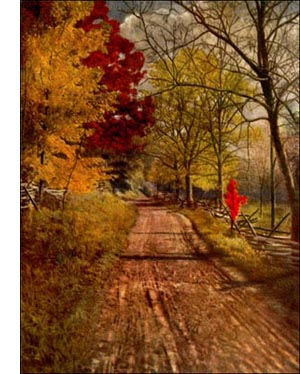Table Mountain Pine Tree
 The Table-Mountain Pine (P. pungens, Michx.), with cones quite as formidable as those of the preceding species, and closely resembling them in appearance, has the same tardy habit of opening and casting its cones that marks P. muricata. But P. pungens is Eastern, growing on gravelly ridges of the Appalachian Mountains from Pennsylvania and New Jersey to North Carolina and Tennessee. It has clustered blue-green foliage of sombre hue, and forms a flattened, irregular head, its long, horizontal branches often drooping, but the twigs erect. The wood is used for fuel and for charcoal in some localities. Its dingy colour, barren habitat and scraggly growth earn it the name, " poverty pine." The thin bark, breaking into loose, scaly plates, is probably responsible for the name, " hickory pine." There is no quality of the brittle, coarse-gained wood to account for it.
The Table-Mountain Pine (P. pungens, Michx.), with cones quite as formidable as those of the preceding species, and closely resembling them in appearance, has the same tardy habit of opening and casting its cones that marks P. muricata. But P. pungens is Eastern, growing on gravelly ridges of the Appalachian Mountains from Pennsylvania and New Jersey to North Carolina and Tennessee. It has clustered blue-green foliage of sombre hue, and forms a flattened, irregular head, its long, horizontal branches often drooping, but the twigs erect. The wood is used for fuel and for charcoal in some localities. Its dingy colour, barren habitat and scraggly growth earn it the name, " poverty pine." The thin bark, breaking into loose, scaly plates, is probably responsible for the name, " hickory pine." There is no quality of the brittle, coarse-gained wood to account for it.It is interesting to note in Bulletin 10 of the Kansas Agricultural College, which is located at Manhattan in the western part of the state, that P. pungens is one of the hardiest and best pines for that region. The leaves are a decided yellow-green there, a cheerful contrast to the sombre Austrian pines so generally planted. The waywardness of the tree's habit is made a virtue. The terminal shoot bends strongly out of the vertical, producing a grotesque leaning tree, which breaks the monotony of the prim and formal European species with which it is successfully grouped in grounds of considerable extent. The following Western species and varieties were tried and failed on the college grounds: P. contorta, edulis, Jeffreyi and ponderosa. Besides P. pungens, other Eastern pines that were successfully grown were rigida and echinata. P. Strobus grew often into handsome, shapely specimens, but died young in the hot winds.